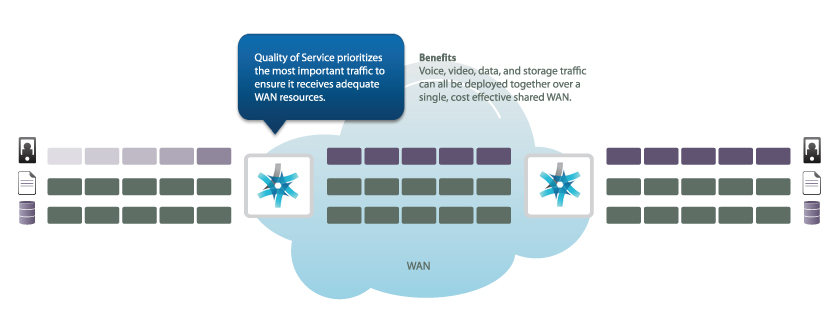With Silver Peak Traffic Shaping, applications are classified to prioritize critical traffic classes while constraining recreational or personal-use traffic classes. Silver Peak offers advanced Quality of Service (QoS) and traffic shaping capabilities to support mixed traffic environments. This includes the following:
- Application Classification. Applications can be classified using the basic elements of a flow: source IP, destination IP, source port, destination port, and protocol. In addition, classification can be made by application and via external DSCP and VLAN tags. Silver Peak supports stateful deep packet inspection to track more complex applications such as FTP and VoIP.
- Packet Marking. This capability enables different service to different packets to avoid deep inspection at each hop and the need for maintaining per-hop state. Our packet marking functionality can be used even when other QoS features, such as shaping, are disabled. They include marking WAN packets based on application classification, incoming LAN packet, or leaving markings unchanged.
- Queuing and Shaping. We employ various QoS mechanisms on the near and far sides of the WAN to improve traffic delivery through congestion points, including queuing policies, dropping disciplines, and service disciplines. Traffic classes can be assigned an absolute priority, a minimum bandwidth guarantee, a maximum bandwidth limit, an excess bandwidth allocation weight, and maximum queues sizes. Real-time applications can be guaranteed by configuring a maximum wait time.
Prioritize the Most Important Traffic

Features
- Sophisticated application classification logic. Includes Deep Packet Inspection (DPI)
- Various packet marking techniques.
- Advanced queuing and traffic shaping. Helps avoid congestion.
- Management tools. Policies are easy to setup and manage across an entire network
Benefits
- Improve performance of all applications by guaranteeing necessary network resources.
- Save money. QoS and traffic shaping integrated with other VXOA features eliminates the need for costly point products.
- Better management and control. Centralized policy templates save time and money when configuring enterprise-wide QoS policies.
Resources
-
Respected industry analyst Jim Metzler examines how SaaS and IaaS are changing the dynamics of the wide area network (WAN).
-
IDC report looks at the role hybrid cloud networks will play in the success of evolving enterprise business models.
-
Quality of Service (QoS) is used to optimize performance in the presence of network impairments and to give preferential treatment to certain classes of traffic in the event that demand exceeds available bandwidth.
-
-
-
As associate director at Linklaters, David Bennett is responsible for the WAN and reports into the CIO as the head of (ISS) Information Systems and Strategy development. He shared a case study of the firm's recent WAN revamp with CIO.com Linklaters is one of the largest law firms in the world, operating in more than 30 locations in 23 countries, advising companies, financial institutions, and governments. The firm's 540 equity partners and 2,000 lawyers cover 18 core practice areas, including capital markets, competition and antitrust, tax, mergers and acquisitions, intellectual property and technology.
-
Autodesk, Inc. is a world leader in 2D and 3D design and engineering software for the manufacturing, building and construction, and media and entertainment markets. Since its introduction of AutoCAD® software in 1982, Autodesk has developed the broadest portfolio of state-of-the-art software applications to help customers experience their ideas digitally before they are built. Fortune 1000 companies rely on Autodesk for the tools to design, visualize and simulate their ideas to save time and money, enhance quality and foster innovation for competitive advantage.